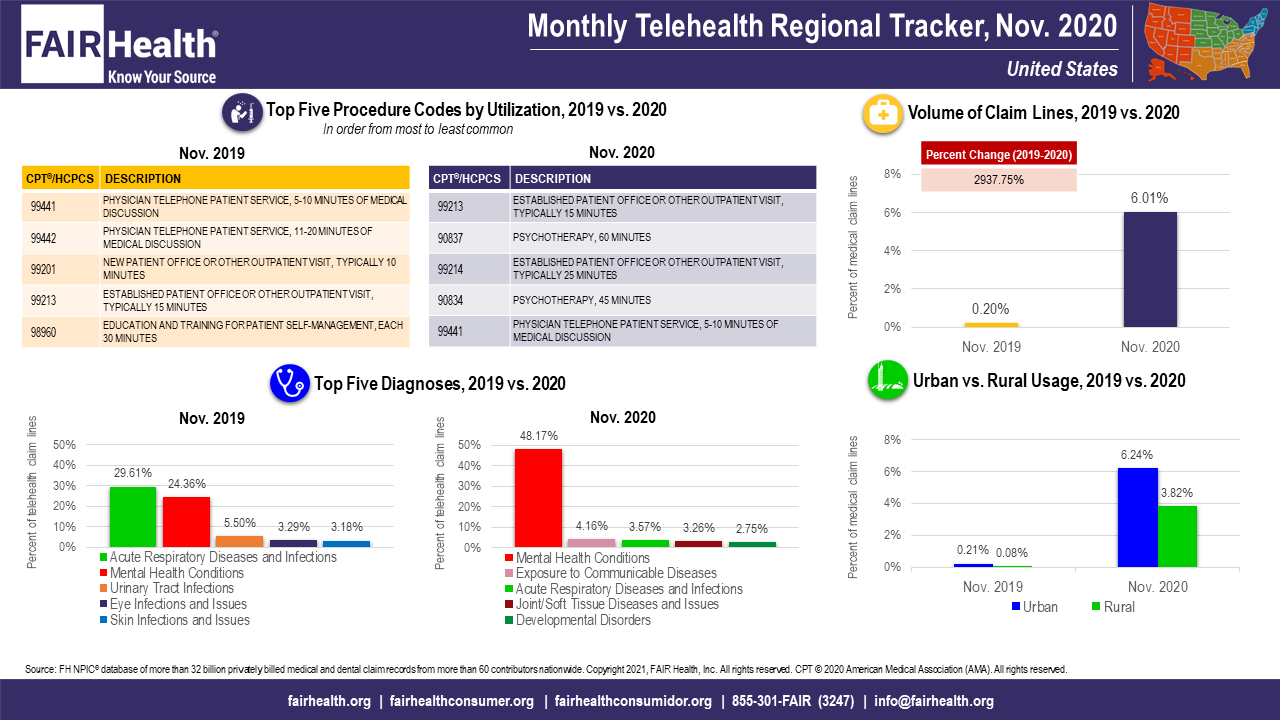Article
Telehealth Claim Lines Rise 2,938 Percent from November 2019 to November 2020
Author(s):
Robin Gelburd, JD, president of FAIR Health, discusses the massive jump in telehealth claims from November 2019 to November 2020.
Telehealth claim lines increased 2938% nationally from November 2019 to November 2020, rising from 0.20% of medical claim lines in November 2019 to 6.01% in November 2020, according to new data from FAIR Health’s Monthly Telehealth Regional Tracker (Figure 1). From month to month, the telehealth share of medical claim lines rose 7.1 percent nationally, from 5.61% in October 2020 to 6.01% in November 2020. The data represent the privately insured population, excluding Medicare and Medicaid.
Figure 1. Monthly Telehealth Regional Tracker, November 2020, United States
Source: FAIR Health

Trends in the 4 US census regions (Midwest, Northeast, South and West) were similar to those in the nation as a whole. In each region, there were large percent increases in volume of claim lines from November 2019 to November 2020; smaller increases occurred from October to November 2020 in every region but the South, where the volume of claim lines dropped 2.5%.
Higher telehealth utilization from March to November 2020 in comparison with the same months in 2019 was likely a result of the COVID-19 pandemic, as patients and providers turned to telehealth as a way of reducing the risk of disease transmission associated with in-person visits.
Other notable findings of the November Monthly Telehealth Regional Tracker concern the top five telehealth diagnoses by volume. In November 2020, COVID-19 appeared for the first time on one of the regional lists of top five telehealth diagnoses, ranking fourth in the Midwest (Exhibit 2). Its appearance may reflect the surging number of COVID-19 cases and relatively fewer telehealth visits for other conditions, such as the flu, cases of which have been unusually low this season.
Figure 2. Monthly Telehealth Regional Tracker, November 2020, Midwest
Source: FAIR Health

Another rising diagnosis was exposure to communicable diseases, probably also related to COVID-19. From October to November 2020, exposure to communicable diseases jumped from number five to number two on the national list of telehealth diagnoses. Simultaneously, it rose in the rankings in all regions except the Midwest, where it stayed at number three, the same as the previous month.
From October to November 2020, mental health conditions remained the number one telehealth diagnosis nationally and in every region. But the percentage of telehealth claim lines represented by mental health conditions fell nationally and in every region, perhaps as a result of an increase in COVID-19-related visits. Nationally, mental health conditions decreased from 51.81% of telehealth claim lines in October to 48.17% in November.
About the Monthly Telehealth Regional Tracker
Launched in May as a free service, the Monthly Telehealth Regional Tracker uses FAIR Health data to track how telehealth is evolving from month to month. An interactive map of the four US census regions allows the user to view an infographic on telehealth in a specific month in the nation as a whole or in individual regions. In addition to data on the volume of claim lines, diagnoses and procedure codes, each infographic includes findings on urban versus rural usage.
As the COVID-19 pandemic persists, FAIR Health’s Monthly Telehealth Regional Tracker is able to provide continuing insights into how it affects telehealth. We will continue to monitor the evolution of this venue of care.
For the Monthly Telehealth Regional Tracker, click here.
Author Information
Robin Gelburd, JD, is the President of FAIR Health, a national, independent nonprofit organization with the mission of bringing transparency to healthcare costs and health insurance information. FAIR Health possesses the nation’s largest collection of private healthcare claims data, which includes over 32 billion claim records and is growing at a rate of over 2 billion claim records a year. Certified by the Centers for Medicare & Medicaid Services (CMS) as a national Qualified Entity, FAIR Health also receives data representing the experience of all individuals enrolled in traditional Medicare Parts A, B and D; FAIR Health includes among the private claims data in its database, data on Medicare Advantage enrollees. Ms. Gelburd is a nationally recognized expert on healthcare policy, data and transparency.




